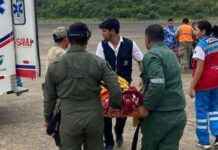On the west bank, reconquered by the Ukrainian army, propaganda signs hung by Vladimir Putin’s party, United Russia, are still visible above shops with gutted windows, while artillery fire is regular hear, noted AFP journalists.
The Kharkiv region, bordering Russia, was partially occupied by Moscow from the start of the invasion launched on February 24. But at the beginning of September, the Ukrainians pushed back the Russians there thanks to a counter-offensive.
At Koupiansk, a railway junction, kyiv’s troops are still fighting: the Russians are entrenched on the other bank, where most of the clashes take place.
On Monday, a stream of civilians sought to flee the bombed city there and where water and electricity have been missing for a week, according to residents.
“It’s impossible to stay where we lived. There were shots (…) every hour,” says Lioudmila, 56, who braved the fighting to cross the river from the east bank to relative safety. from the west shore. “It’s very hard there,” she says.
“There has been no light, no electricity, for a week. No water,” Rouslan, a 49-year-old former policeman, told AFP.
– Gutted bridges –
Most of the fire heard Monday came from Ukrainian tanks and artillery, but as a small unit of soldiers from kyiv advanced towards a bridge painted in the red-white-blue colors of Russia, a fierce exchange of rockets and shell burst.
Ukrainian soldiers took cover under a gutted brick building, as a plume of smoke rose into the sky in the distance. Nearby, a sign proclaims: “We are with Russia. One nation”.
Military experts believe that a Ukrainian reconquest of Kupyansk, which had some 58,000 inhabitants before the war, would make it more difficult to supply Russian forces deployed further south to protect their gains in the industrial basin of Donbass, a priority strategic objective of the Russian president. Vladimir Poutine.
Kupyansk is also a road crossing point of the Oskil River, and several of its bridges have been damaged in the fighting.
A bearded Ukrainian doctor riding a quad, according to him the best vehicle for negotiating cracked and twisted bridges, told AFP that he had brought back an injured civilian from the other side, his third in two days.
As families cower at the side of the road on the west side of town waiting for transportation, a Ukrainian tank on a small hill fires shells over their homes, targeting Russians in eastern the city.
“The Ukrainians are getting closer, but there are still Russian troops in some parts of the city,” confirms Olena Glushko, a 33-year-old resident, before adding: “It’s just terrifying. It’s horrible.”
Ukrainian troops are now ubiquitous in the city, speeding into rebuilt civilian vehicles or marching in line with sacks of supplies.
When Olena first saw them after six months of Russian occupation, she was devastated. “I wanted to burst into tears and laugh at the same time,” she says.








